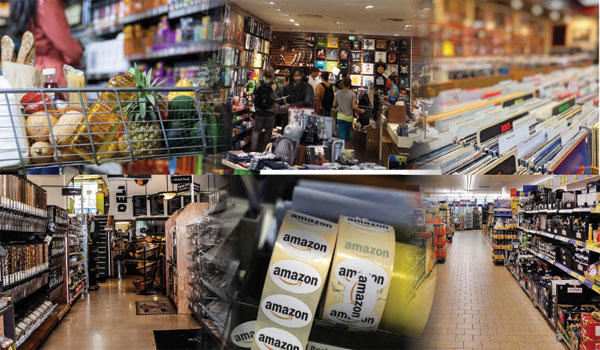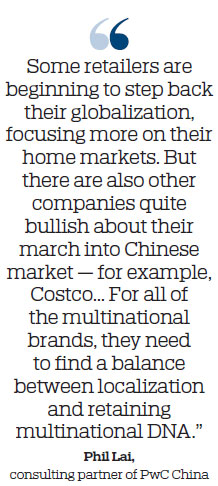E-commerce culture clash tests foreign online retailers
Updated: 2019-07-12 07:42
By Edith Lu(HK Edition)
|
|||||||
Global internet vendors have found the going rough in China. As Edith Lu reports, foreign enterprises have yet to get used to local consumer habits and preferences, let alone fine-tuning their strategies.
Nobody can say no to a $1.50 hot dog with unlimited drinks, a $4.99 roast chicken, or a tire replacement service for only $15 - especially Chinese consumers.
Their enthusiasm for bargains has put e-commerce platform Pinduoduo on the Nasdaq Stock Exchange, and has also attracted the attention of Costco Wholesale Corp, the second-largest retailer in the world.
Famous for selling good-quality products at low prices, Costco announced in May that it is set to open its first brick-and-mortar store on the Chinese mainland at the end of August, marking its first foray into the competitive market.

The membership-driven warehouse-club retailer dipped its toe into the Chinese market in 2014 by selling on Tmall Global, a cross-border business-to-consumer (B2C) platform under Alibaba.
But Costco no longer has its traditional pricing advantages in China due to the import tariffs. The key to its expansion now is whether it can adapt to the retail realities of China - a goal that has eluded other foreign retailers.
A tough market to crack for foreign companies
For foreign companies, breaking into China's retail market - and the world's largest e-commerce market - has always been a tough nut to crack. Even global e-commerce giant Amazon could not escape the challenges and consequences.
Amazon has declared that it plans to shut down part of its Chinese marketplace business in mid-July, which means that Chinese customers will no longer be able to buy domestic merchants' goods on Amazon.
Many local merchants on Amazon China, including Momax, are ending their e-commerce business on the platform these days.
The Hong Kong- and Shenzhen-based smartphone-accessories maker used to operate its major online business on Amazon, as well as Tmall and JD.com. But withdrawing from Amazon isn't a major setback, company officials said.
Momax Sales Director Aden Li Dong said the impact of closing is minimal to the company since Amazon is not Momax's key e-commerce platform. The cost of inventory and manpower is next to nothing, as Momax's warehouse does not serve only Amazon.
According to Li, sales from Amazon and other cross-border platforms account for less than 10 percent of the company's total e-commerce income. The biggest earners are Tmall and JD, occupying 40 percent and 30 percent, respectively.

He said Momax cooperated with Amazon mainly for its cross-border business, as Momax hoped to leverage the platform to lure more overseas buyers.
Amazon described its partial retreat as a focus shift so that it can do a better job offering Chinese consumers overseas products. Meanwhile, it will continue to run businesses such as Kindle e-books, Amazon Web Services, and other cross-border operations in China.
The company has been operating in China for almost 15 years. In 2004, Amazon got a toehold in China when it bought local online book seller Joyo.com for $75 million.
Amazon's success in China short-lived
As a leader in the e-commerce sector, Amazon was an up-and-comer at the very start.
With the well-known brands and quality products in its self-operated stores, Amazon China saw sales approach nearly $7 billion for its first year. At that time, Alibaba had not launched Tmall, its B2C division, and JD had not yet raised its first round of funds.
But Amazon's good times did not last long. The e-commerce industry expanded rapidly. Platforms based on third-party merchants such as Alibaba's Taobao sprang up and priced out the competition, while Amazon did not introduce third-party merchants to its platform until 2012.
"The market share of Amazon has dropped from its peak of 15 percent to, at one time, less than 1 percent," said Michael Cheng Woon-yin, PwC consumer markets leader of Asia Pacific, Hong Kong and the Chinese mainland.
He questioned Amazon's competitiveness in China, as its promotion events are not attractive enough to woo Chinese customers compared with its local rivals. And most of its business model, including its payment method and membership discount, just copies its US website without localization.
When Amazon founder Jeff Bezos visited China in 2007, he was asked why so many global internet companies failed here, including eBay and Yahoo.
Bezos said it was terrible to see these multinational firms come just to satisfy their foreigner bosses rather than local customers. However, years later, the company of the world's wealthiest man stumbled in China for the same reason.
"Amazon China does not have much power to make decisions," said Jin Tai (not her real name), a former Amazon China account manager who was based in Shanghai. "All the decisions need to be reviewed by the headquarters in the US."
She cited product information displays as an example. When people search a certain item, local online platforms display all merchants that are selling the product. However, Amazon automatically designates one seller as the item's default seller. This means that the other sellers have no chance to be visited unless customers specifically click through to see them.
Amazon's reason for doing this was to improve the shopping experience by providing the most cost-effective product. But that method is unfamiliar to Chinese consumers and does not match their shopping habits.
"We have reported these kinds of problems to the US, but they just insist websites of different marketplaces should have a consistent style," said Jin, paraphrasing what she was told during her training.
Jin left the company after a year because she found she could learn little from the work.
Retailers must adapt to changing market
However, localization by itself is not enough to conquer the Chinese market. Retailers have to adapt to the dynamic changes rapidly and catch targeted consumers' attention, Cheng said.
He summarized the preferences of the main forces in e-commerce: The post-'80s shoppers liked cost-effective products; the post-'90s generation valued the brand more; and the post-'00s preferred an integrated platform.
These features explain the rise of a group of new e-commerce platforms. On one hand, people go gaga over products at fire-sale prices on Pinduoduo. On the other hand, girls in their 20s are addicted to the small bourgeois world created by Xiaohongshu, an e-commerce platform operating like a mash-up of Instagram and Amazon. It provides a channel for its young consumers to buy luxury items or expensive skin-care products as soon as they check some bloggers' recommendations.
"Although sales from these kinds of new e-commerce platforms now account for only 20 percent of our total e-commerce income, the proportion is going up," Li said, adding that Momax has started to tap deeper into these platforms, as social e-commerce platforms and live promotions are becoming increasingly popular.

Even traditional e-commerce giants such as Taobao have included some social media elements. Sellers can update new posts every day to increase exposure and maintain the relationship with regular customers. Live promotion for new-arrived goods is also needed, which could greatly increase the sales of products.
Jeffrey Huang, a Zhejiang-based e-commerce retailer, saw the business model of these new e-commerce platforms as a trend. As a retailer, he must go after to "gain more volume and more turnover".
The household-slipper retailer, whose business runs across every major e-commerce platform, ventured into Pinduoduo in 2017. But soon his store shifted the emphasis to other platforms, since the rock-bottom prices on Pinduoduo provide too small a profit. Now it mainly focuses on social ones.
But Huang is still positive about traditional platforms. "The rise of new platforms doesn't mean there's no market for traditional ones. Though new forms are springing up, many shut down quickly," he said. Thus, the retailer will continue the business on traditional platforms such as Tmall.
Online, offline selling platforms integrate
In addition, many platforms are integrating their online and offline platforms. Alibaba is transferring its business from one that is solely online to an online-to-offline (O2O) platform as well. Its offline supermarket chain, Hema Xiansheng, allows consumers to order groceries online and have them delivered to their doorstep, or they can shop at the physical stores and ask to have the goods delivered to their homes.
Once an e-commerce platform focusing mainly on electronic appliances, Suning.com has been gearing up its offline presence in recent years and realized its transformation through its O2O business model. It announced earlier this year that it will acquire all Wanda Department Stores to expand its offline presence.
Last month, Suning agreed to buy an 80-percent stake in the Chinese unit of Carrefour for 4.8 billion yuan ($698 million). The French supermarket chain has been searching for a local partner for a long time, trying to save its struggling operations in China.
Before the deal with Suning, Carrefour had been in discussions with Tencent and Yonghui Superstores regarding a potential investment and cooperation to bring together its retail knowledge with Tencent's digital expertise and innovation capabilities.
According to the company's annual report, sales of Carrefour China slumped almost 10 percent to 3.65 million euros ($4.11 million) last year.
Chinese Commerce Ministry spokesman Gao Feng said the purchase is simply a strategic collaboration as a normal market behavior.
He stressed the retail sector in China is a perfectly competitive market. The ministry will take affirmative steps to promote the integration of online and offline, as well as consumption transformation and upgrading, he added.
Like Carrefour, a growing number of foreign retailers are tying up with local players in order to survive in China. Walmart, which has a network of around 400 outlets, relies on JD for its delivery service, while Germany's Metro AG is trying to offload a majority stake in its Chinese business.
"Different companies just have different global strategies," said Phil Lai, consulting partner of PwC China.
"Some retailers are beginning to step back their globalization, focusing more on their home markets. But there are also other companies quite bullish about their march into the Chinese market - for example, Costco."
Lai agrees that collaboration with major local partners is a key to success in China since it will be easier for them to create so-called "customer stickiness" and read the hearts of Chinese consumers.
"For all of the multinational brands, they need to find a balance between localization and retaining multinational DNA," Lai said.
Contact the writer at edithlu@chinadailyhk.com
(HK Edition 07/12/2019 page8)